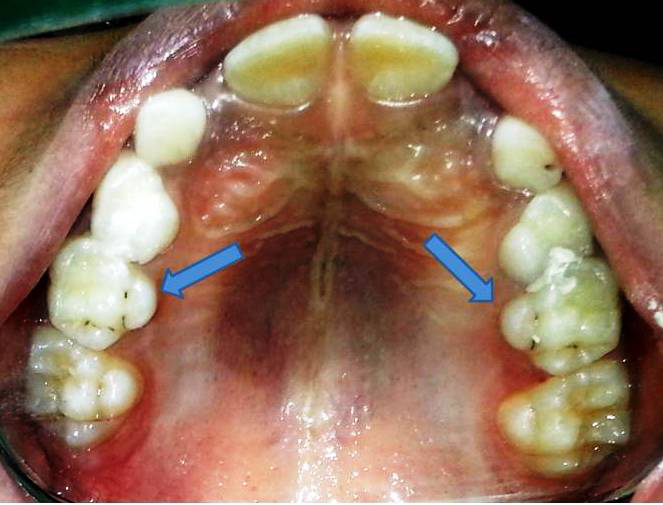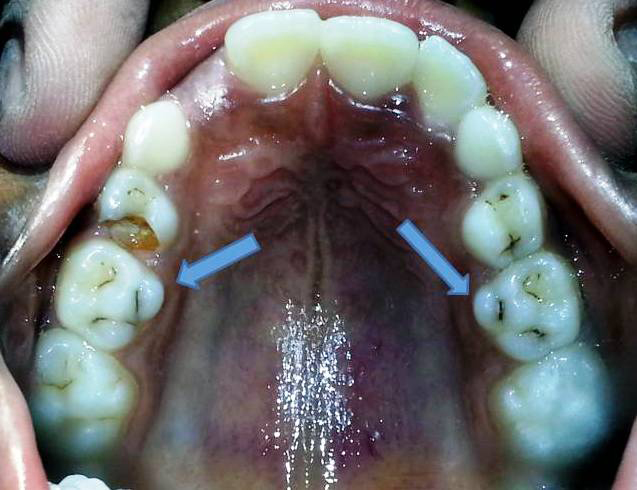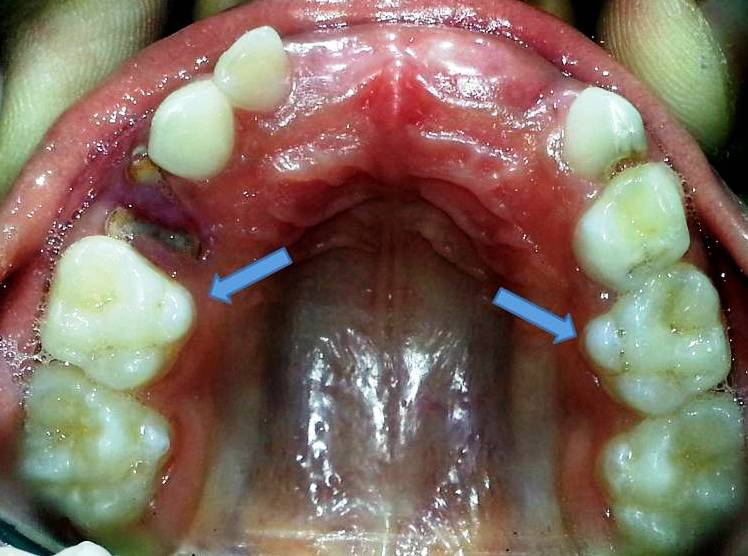Occurrence of Cusp of Carabelli in Primary Second Molar Series of three Cases
Mythri Sarpangala1, Ashwin Devasya2
1 Senior Lecturer, Department of Periodontology, Kannur Dental College, Anjarakkandy, Kannur, Kerala, India.
2 Senior Lecturer, Department of Paedodontics and Preventive Dentistry, Kannur Dental College, Anjarakkandy, Kannur, Kerala, India.
NAME, ADDRESS, E-MAIL ID OF THE CORRESPONDING AUTHOR: Dr. Ashwin Devasya, Bhat’s Multispeciality Clinic, Oberle Complex, Above Kottodal Hardwares Badiyadka Road, Kumbla, Kasargod-671321, Kerala, India.
E-mail: ashwindkumbla@gmail.com
Morphological variations are seen in both primary and permanent dentitions. Cusp of Carabelli is also one of them. It is suggested that it is due to over activity of dental lamina but definitive aetiology is unknown. It is a type of accessory cusp, occurs more often in permanent maxillary first molars, whereas, its occurrence in primary tooth is rare. The present case series discusses the presence of cusp of Carabelli in primary maxillary second molars in three different cases. This case series will help clinicians to identify, diagnose and take proper preventive care and also adds to the incidence in literature.
Accessory cusp, Carabelli trait, Maxillary molars
The cusp of Carabelli, is also known as Carabelli tubercle, tuberculum anomale of Georg Carabelli. It was first described in 1842 by the Hungarian Georg Carabelli. This is a morphological variation which takes the form of fifth cusp or it can grade down to a series of grooves, depressions or pits on the mesial portion of the lingual surface. This cusp is found lingual to the mesiolingual cusp of maxillary first permanent molar, which is the largest of the well-developed cusps and becomes less prominent in second and third molars [1,2].
The aetiology is unknown, but it is suggested that it might be due to overactivity of dental lamina. A genetic and exogenous factor seems to have an influence on formation of this cusp [3]. The incidence of this cusp is more in maxillary permanent first molar and rarely seen in primary second molars. The presentation is usually bilaterally. The frequency of occurrence is reported to be high in Europeans than in Asians. Males are more affected than females at the ratio1.2:1 [4].
Not many studies have been done or reported about the cusp of Carabelli and its influences. It is seldom seen in primary dentition. This case series describes three individuals with cusp of Carabelli in primary maxillary second molar which is a rare presentation.
Case 1
A seven-year-old male patient reported (accompanied by parents) with a chief complaint of food lodgment in upper back tooth region. Patient was visiting dentist for the first time. Extraorally no abnormalities were noticed, on intraoral examination, it was noticed that the child had mixed dentition with maxillary permanent centrals and permanent molars erupted and deep proximal caries was found in left deciduous first molar. It was observed that there was a presence of prominent cusp of Carabelli in primary second molars bilaterally. Based on the Dahlberg classification [5], cusp was classified as, Dahlberg Type 6. Presence of Carabelli cusp was also noticed bilaterally, on permanent first molars [Table/Fig-1].
Cusp of carabelli in primary maxillary second molar and maxillary permanent first molar edited.

Based on the chief complaint, parents were suggested stainless steel crown as a restoration. Since parents refused for that, a temporary restoration was done with zinc oxide eugenol cement. The groove separating the prominent cusp was discolored and sealant was placed in subsequent visit.
Case 2
An eight-year-old male patient reported (accompanied by parents) with a chief complaint of unerupted permanent front tooth. On intraoral examination, it was observed that the patient had mixed dentition and left deciduous first molar was carious. The parent was assured that permanent lateral will erupt; presence of the tooth was confirmed with a radiograph. Pulpectomy of maxillary left deciduous first molar was carried out as treatment plan and in the next appointment placement of sealants done for other molar teeth.
But interestingly, there was a prominent cusp of Carabelli in the primary second molar tooth bilaterally in a shape of small tubercle (Type 5). But contrary to the first case, it was not prominent in permanent molars [Table/Fig-2].
Prominent cusp of Carabelli in primary maxillary second molar teeth bilaterally.

Case 3
A six-year-old female patient reported with a complaint of pain in upper right back tooth region. An intraoral examination revealed the presence of root stumps of primary maxillary right first molar teeth, and proximal caries in the maxillary left primary canine. Extraction of root stumps and space maintainer was suggested along with restoration of canine. The presence of prominent cusp of Carabelli was seen in this case bilaterally (type 6) in the primary second molar as well as in permanent first molars [Table/Fig-3].
Prominent cusp of Carabelli in maxillary primary second molar bilaterally.

All the three case reports showed the presence of prominent cusp of Carabelli in maxillary primary second molar as well as on maxillary permanent first molars. Presence of Carabelli trait in primary molars is rare.
Discussion
Carabelli’s cusp is a type of accessory cusp which may vary in size and shape, composed of enamel, dentine with or without pulpal extension. The genetic aetiology of cusp of Carabelli suggests that the genes PAX and MSX genes are responsible [3].
The evolutionary perspective of this cusp is that it is an adaptation in the buccolingual direction which might fade off with aging. The functional perspective being able to bear the biomechanical stress by broadening the occlusal table of molar tooth [5].
Even though it is non-functional, it can be used to distinguish population, also used in forensic and anthropological studies [6]. The groove separating the cusp may be prone to caries and there might be problems in placement of orthodontic bands due to improper adaptation [4].
As per previous Indian studies, 52.77% of maxillary permanent molars displayed a Carabelli tubercle [7]. Carabelli’s trait was present in 26-27% of Asian population. High expression of Carabelli trait (89.8% in primary second molars) was found in southern Indian population [8]. Caucasian population had higher occurrence of Carabelli trait than Mongoloids [6].
Based on the available studies [Table/Fig-4] [6,8–16], the occurrence of prominent cusp of Carabelli in primary dentition is low in Asian population when considering the permanent dentition. Hence, occurrence of a definite cusp of Carabelli on the primary maxillary second molar was relatively infrequent.
List of studies on Carabelli trait in deciduous dentition [6,8–16].
| Keerthiga M [6] | 2016 | Carabelli trait in mixed dentition Indian population |
| Kamatham R [8] | 2014 | Carabelli trait in mixed dentition Southern Indian children |
| Townsend GC [9] | 1981 | Carabelli trait in Australian dentition |
| Smith P [10] | 1988 | Carabelli trait in mixed dentition in Israel |
| Thomas CJ [11] | 1986 | Carabelli trait in mixed dentition in South Africa |
| Kieser JA [12] | 1984 | Carabelli trait in mixed dentition |
| Nagarajan S [13] | 2009 | Case report on bilateral occurrence of Carabelli cusp in deciduous maxillary 2nd molar |
| Sadatulla S [14] | 2012 | Prevalence study of Carabelli trait in Saudi Arabian children |
| Herman K [15] | 2014 | Prevalence study of Carabelli trait in Poland children |
| Roopa KB [16] | 2015 | Case report on bilateral occurrence of Carabelli cusp in deciduous molars |
Conclusion
Morphological variations like accessory cusps are common in primary and permanent dentition. Presence of cusp of Carabelli in primary dentition is a rare phenomenon. They are either unnoticed or not reported. Clinically, they may not have much importance but are important from forensic point of view. Presence of such anomalies may lead to dental problems hence proper guidance and treatment should be carried out.
[1]. Scheid RC, Woelfel’s Dental Anatomy: Its relevance to dentistry 2007 7th edMarylandLippincott Williams and Wilkins:243-50. [Google Scholar]
[2]. Alvesalo N, Nuutila M, Portin P, The cusps of Carabelli, occurrence in first upper molars and evaluation of its heritabilityActa Odontologica Scandinavica 1975 33:191-97. [Google Scholar]
[3]. Sedano HO, OcampoAcosta F, NaranjoCorona RI, TorresArellano ME, Multiple dens invaginatus, mulberry molar and conical teeth. Case report and genetic considerationsMed Oral Patol Oral Cir Bucal 2009 14:69-72. [Google Scholar]
[4]. Falomo OO, The cusp of Carabelli: Frequency, distribution, size and clinical significance in NigeriaWest Afr J Med 2002 21:322-24. [Google Scholar]
[5]. Dahlberg AA, The dentition of the American Indian. In: Laughlin WS, editorThe physical anthropology of the American Indian 1949 New YorkViking Fund:138-76. [Google Scholar]
[6]. Kirthiga M, Manju M, Praveen R, Umesh W, Ethnic association of cusp of Carabelli Trait and Shovelig Trait in an Indian PopulationJ Clin Diagn Res 2016 10(3):ZC78-81. [Google Scholar]
[7]. Kanappan JG, Swaminathan S, A study on dental morphological variation. Tubercle of CarabelliIndian J Dent Res 2001 12:145-49. [Google Scholar]
[8]. Kamatham R, Nuvvula S, Expression of Carabelli trait in children from Southern India - A cross sectional studyJ Forensic Dent Sci 2014 6:51-57. [Google Scholar]
[9]. Townsend GC, Brown T, carabelli trait in Australian aboriginal dentitionArch Oral Biol 1981 26:809-14. [Google Scholar]
[10]. Smith P, Koyoumdjisky-Kaye E, Kalderon W, Stern D, Directionality of dental trait frequency between human second deciduous and first permanent molarsArch Oral Biol 1987 32:5-9. [Google Scholar]
[11]. Thomas CJ, Kotze TJ, Nash JM, The Carabelli trait in the mixed deciduous and permanent dentitions of five South African populationsArch Oral Biol 1986 31:145-47. [Google Scholar]
[12]. Kieser JA, An analysis of the Carabelli trait in the mixed deciduous and permanent human dentitionArch Oral Biol 1984 29:403-06. [Google Scholar]
[13]. Nagarajan S, Sockalingam MP, Mahyuddin A, Bilateral accessory central cusp of 2nd deciduous molar: an unusual occurrenceArchives of Orofacial Sciences 2009 4:22-24. [Google Scholar]
[14]. Sadatullah S, Odusanya SA, Mustafa A, Abdul Razak P, Abdul Wahab M, Meer Z, The prevalence of fifth cusp (cusp of carabelli) in the upper molars in saudi arabian school studentsInt J Morphol 2012 30:757-60. [Google Scholar]
[15]. Herman K, Wrzyszcz-Kowalczyk A, Kaczmarek U, Kobierska-Brzoza J, The Prevalence and Expression of Carabelli Trait in Permanent and Deciduous MolarsDent Med Probl 2014 51:330-35. [Google Scholar]
[16]. Roopa KB, Poornima P, Pathak S, Neena IE, Bilateral supernumerary cusps on deciduous and permanent molars: A case report with a short reviewInt J Contemp Dent Med Rev 2015 :132-34. [Google Scholar]